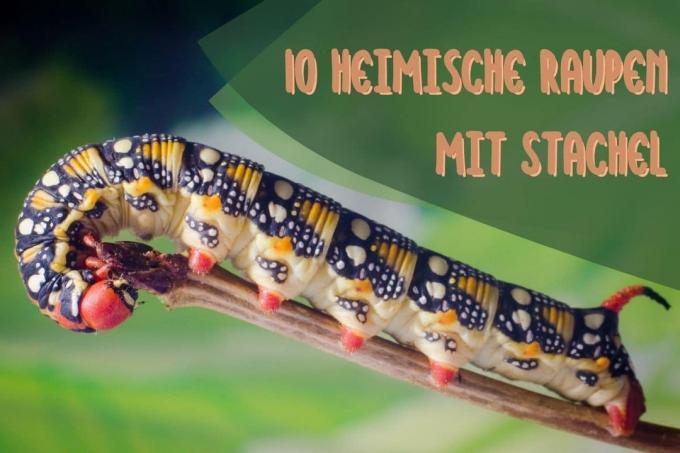
table of contents
- Evening peacock butterfly (Smerinthus ocellata)
- Bumble bee (Hemaris fuciformis)
- Pine hawk (Sphinx pinastri)
- Bedstraw hawk (Hyles gallii)
- Privet hawk (Sphinx ligustri)
- Linden Hawk (Mimas tiliae)
- Poplar Hawk (Laothoe populi)
- Scabiosa swarmers (Hemaris tityus)
- Pigeon tail (Macroglossum stellatarum)
- Spurge Hawk (Hyles euphorbiae)
- frequently asked Questions
Don't be frightened if you spot a caterpillar with a stinger in the garden. In most cases it is a harmless caterpillar of the hawkmoth family (Sphingidae).
In a nutshell
- The swarmers' caterpillars have a thorn-like structure on the 8th. Abdominal segment
- it is an anal horn that scares off predators
- Swarmers often grow very large
- the caterpillars are harmless to humans
- 20 species in Central Europe, 1200 species known worldwide
Evening peacock butterfly (Smerinthus ocellata)

- Occurrence: all over Europe, in orchards, parks, damp forests
- Occurrence: July to September
- Size: 7 to 8 centimeters
- Color: first green, then pink
- Feature: blue anal horn
- Forage plants: willow (Salix), poplar (Populus), apple tree (Malus)
- Toxicity: no
- Endangerment: no
Bumble bee (Hemaris fuciformis)

- Occurrence: everywhere in Europe, on the edges of forests, on flower meadows
- Occurrence: April to May, June to July
- Size: 3.5 to 4 centimeters
- Color: light green, white longitudinal line on the sides, rough surface with point warts, dark colored belly
- Characteristic: reddish anal horn, dark at the end
- Forage plants: bedstraw (Galium), honeysuckle (Lonicera), rhododendron (Rhododendron)
- Toxicity: no
- Endangerment: yes
Pine hawk (Sphinx pinastri)
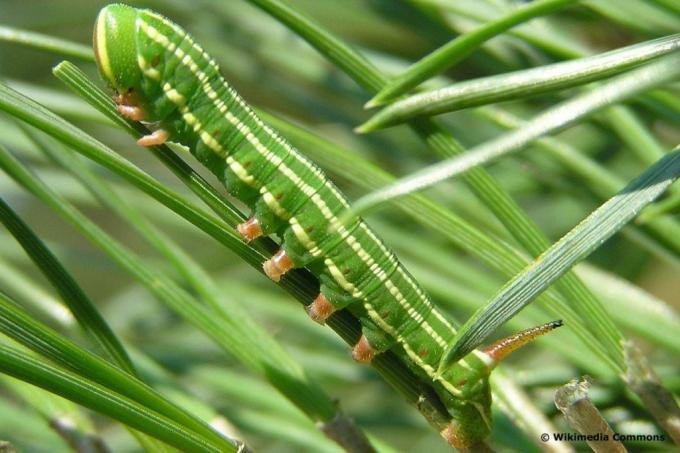
- Occurrence: everywhere in Central and Southern Europe, in coniferous forests
- Occurrence: April to May
- Size: 7.5 to 8 centimeters
- Color: green with a brown back, creamy white vertical stripes on the sides, lighter head with dark stripes, an oily sheen before pupation
- Feature: dark anal horn
- Forage plants: pine (Pinus), spruce (Picea)
- Toxicity: no
- Endangerment: no
Note: The pine hawk is one of the most common hawk species in Central Europe. It is also known as the fir arrow.
Bedstraw hawk (Hyles gallii)
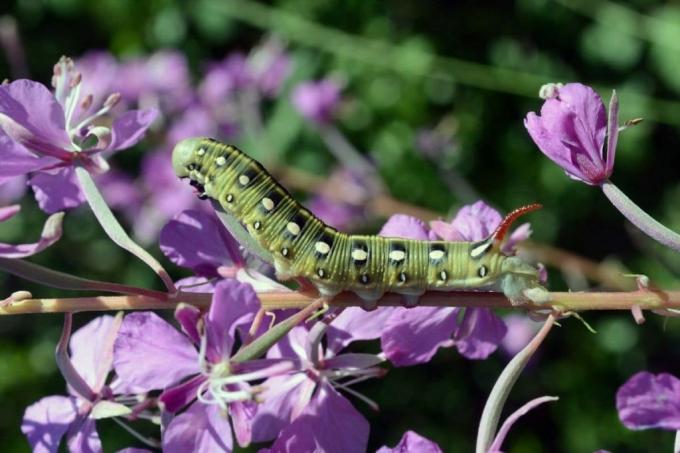
- Occurrence: everywhere in Central Europe, at forest edges, in spas, on heathland
- Occurrence: July to September
- Size: 7 to 8 centimeters
- Coloring: green or brown with black spots or black with yellow spots, red legs
- Feature: red anal horn
- Forage plants: bedstraw (Galium), fireweed (Epilobium angustifolium) Toxicity: no
- Endangerment: especially protected
Privet hawk (Sphinx ligustri)
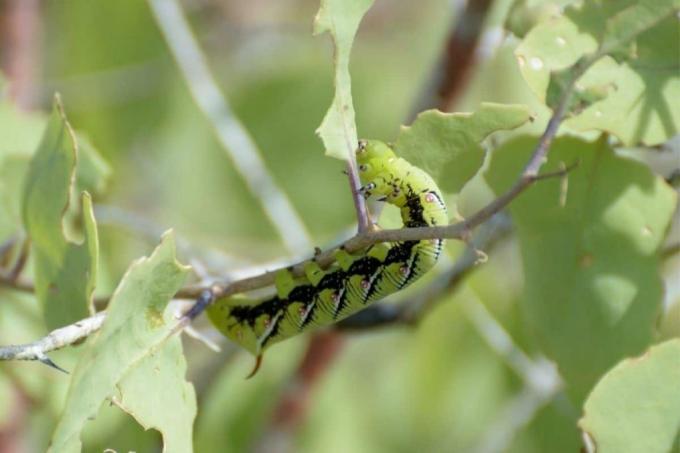
- Occurrence: everywhere in Central Europe, at the edges of forests, in parks and gardens
- Occurrence: July to September
- Size: 9 to 10 centimeters
- Color: bright green, white-pink or white-purple stripes, yellow dots
- Characteristic: bright anal horn, glossy black at the end
- Forage plants: privet (Ligustrum), lilac (Syringa), ash (Fraxinus)
- Toxicity: no
- Endangerment: no
Linden Hawk (Mimas tiliae)
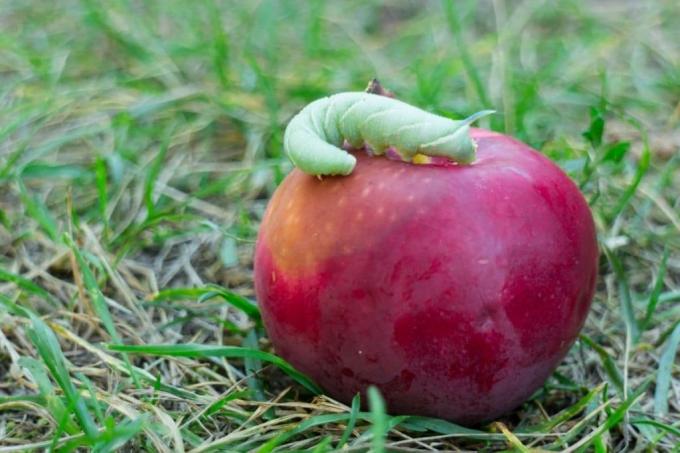
- Occurrence: everywhere in Central Europe, on the edges of forests, in parks and avenues
- Occurrence: April and July
- Size: 4 to 5.5 centimeters. Color: pale green or pale blue, triangular head capsule
- Feature: blue-purple anal horn
- Forage plants: Linden (Tilia), alder (Alnus), elm (Ulmus)
- Toxicity: no
- Endangerment: no
Poplar Hawk (Laothoe populi)
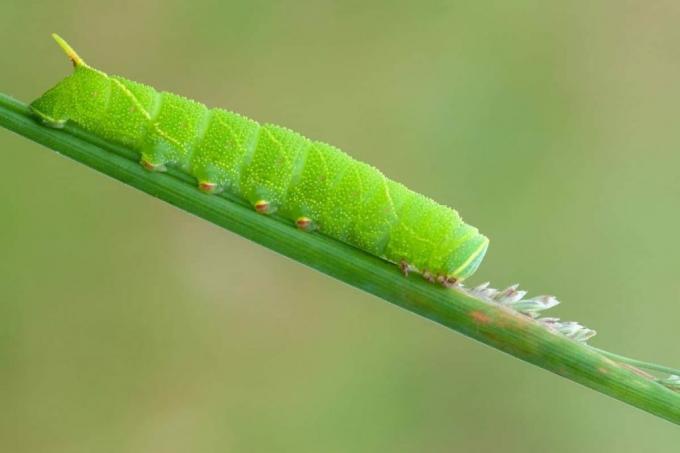
- Occurrence: all over Europe, in forests, gardens and parks
- Occurrence: April to May
- Size: 4 to 5 centimeters
- Color: green with yellow horizontal stripes
- Feature: yellow anal horn
- Forage plants: Poplar (Populus), Willow (Salix)
- Toxicity: no
- Endangerment: no
Scabiosa swarmers (Hemaris tityus)
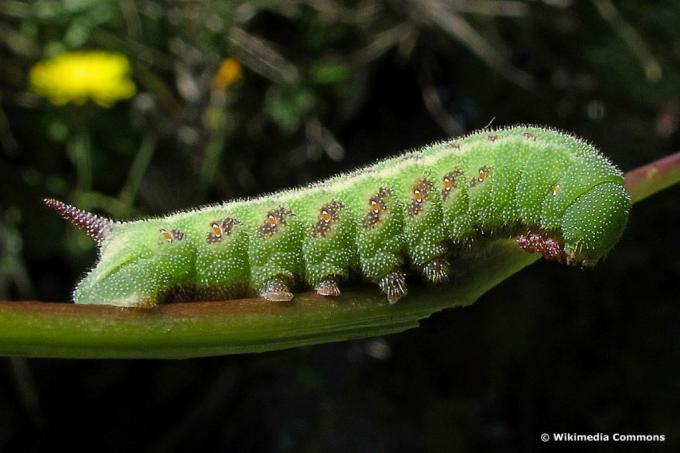
- Occurrence: everywhere in Europe, at the edges of forests, in gardens
- Occurrence: April to May, June to July
- Size: 4 to 5 centimeters
- Color: initially green, later purple throughout, light longitudinal lines on both sides of the body, purple spots in each segment
- Characteristic: reddish anal horn, two black hairs at the end
- Forage plants: Scabiosa (Scabiosa), common devil's bite (Succisa pratensis), bedstraw (Galium)
- Toxicity: no
- Endangerment: yes
Pigeon tail (Macroglossum stellatarum)

- Occurrence: everywhere in Central and Southern Europe, in gardens and parks
- Occurrence: April to June
- Size: 4.5 to 5 centimeters
- Color: mostly green or brown, white spots on the body, one yellow and one white longitudinal line on the sides
- Characteristic: green anal horn, black and yellow at the end
- Forage plants: bedstraw (Galium), spurflower (Centranthus), madder (Rubia tinctorum), woodruff (Galium odoratum)
- Toxicity: no
- Endangerment: no
Spurge Hawk (Hyles euphorbiae)
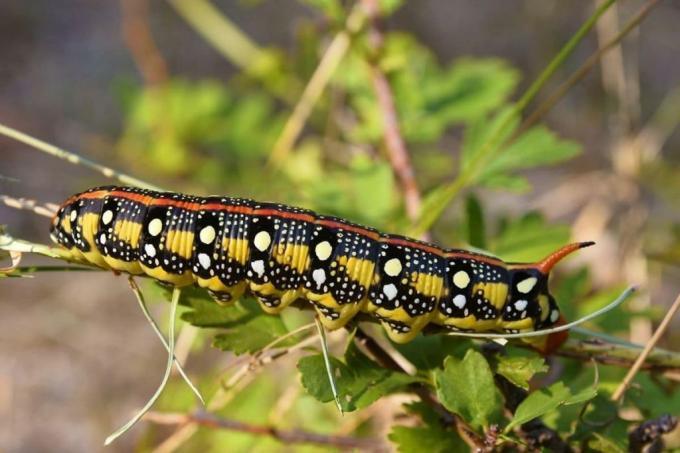
- Occurrence: everywhere in Central Europe, open grasslands
- Occurrence: April to May, sometimes also August to September
- Size: 7 to 9 centimeters
- Coloring: red base color, white and small black spots on the sides, large yellow, green or orange spots, yellow or red longitudinal line on the sides
- Feature: red anal horn with black tip
- Forage plants: beach spurge (Euphorbia paralias), cypress spurge (Euphorbia cyparissias)
- Toxicity: The intestinal contents are poisonous for predators
- Endangerment: endangered species, is on the red list
Note: The milkweed hawk, which emerges from the colorful caterpillars with sting, is considered to be the largest moth in Central Europe with a wingspan of 9 to 11 centimeters.
frequently asked Questions
The hawkmoth caterpillars look impressive with the sting on their abdomen, but they are harmless to humans. In contrast to them, caterpillars of the oak processionary moth (Thaumetopoea processionea) can cause severe itching and skin irritation.
Without caterpillars there are no butterflies and no moths! Most caterpillars do not do much damage. Provide good nesting opportunities for songbirds. Protect endangered plants by collecting them regularly and using glue rings.
The parasitic wasps and sand wasps are important enemies of the caterpillars. Parasitic wasps lay their eggs in the caterpillars, which then die. Sand wasps paralyze caterpillars with a poison and gradually eat them up.
